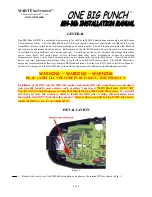
22
English
Procedure
Daily
Weekly Monthly
1 year or
200 Hours
Check for unusual noise/
vibration
X
Check for air leaks*
X
Clean compressor exterior
X
Engine
See engine instruction manual.
* To check for air leaks apply a solution of soapy water around joints.
While compressor is pumping to pressure and after pressure cuts out,
look for air bubbles to form.
** The pump oil must be changed after the first 20 hours or operation.
Thereafter, when using
D
e
WALT
synthetic compressor oil, change oil
every 200 hours of operation or once a year, whichever comes first.
+ Perform more frequent in dusty or humid conditions.
Checking Safety valve (Fig. 1)
WARNING
: Hot surfaces. Risk of burn. aftercooler, pump head,
and surrounding parts are very hot, do not touch (see the Hot
Surfaces identified in Fig. 2). allow compressor to cool prior to
servicing.
WARNING:
Risk of bursting. If the safety valve does not work
properly, over-pressurization may occur, causing air tank rupture or
an explosion.
Before starting compressor, pull the ring on the safety valve to
make sure that the safety valve operates freely. If the valve is stuck
or does not operate smoothly, it must be replaced with the same
type of valve.
Checking Air Filter Element (Fig. 1)
WARNING
: Hot surfaces. Risk of burn. aftercooler, pump head,
and surrounding parts are very hot, do not touch (see the Hot
Surfaces identified in Fig. 2). allow compressor to cool prior to
servicing.
1. Ensure engine START/RUN/OFF switch (C) is in the OFF posi-
tion.
2. Allow unit to cool.
3. Remove filter (A) top from filter base by turning filter counter-
clockwise about 5 degrees.
4. Separate filter top from base.
5. Remove element from filter base.
6. If element needs cleaning, blow out with air. Replace if needed.
Purchase replacement parts from your local dealer or authorized
service center. Always use identical replacement parts.
7. Place element back in filter base.
8. Reconnect filter top to filter base. While pushing in, rotate clock-
wise 5 degrees.
CAUTION:
Risk of unsafe operation. Do not operate without air
filter.
Draining Air Tank (Fig. 1)
WARNING:
Risk of unsafe operation. Risk from noise. air tanks
contain high pressure air. Keep face and other body parts away from
outlet of drain. Use eye protection [aNSI Z87.1 (CaN/CSa Z94.3)]
when draining as debris can be kicked up into face.
WARNING:
Risk from noise. Use ear protection [aNSI S12.6
(S3.19)] as air flow noise is loud when draining.
















































